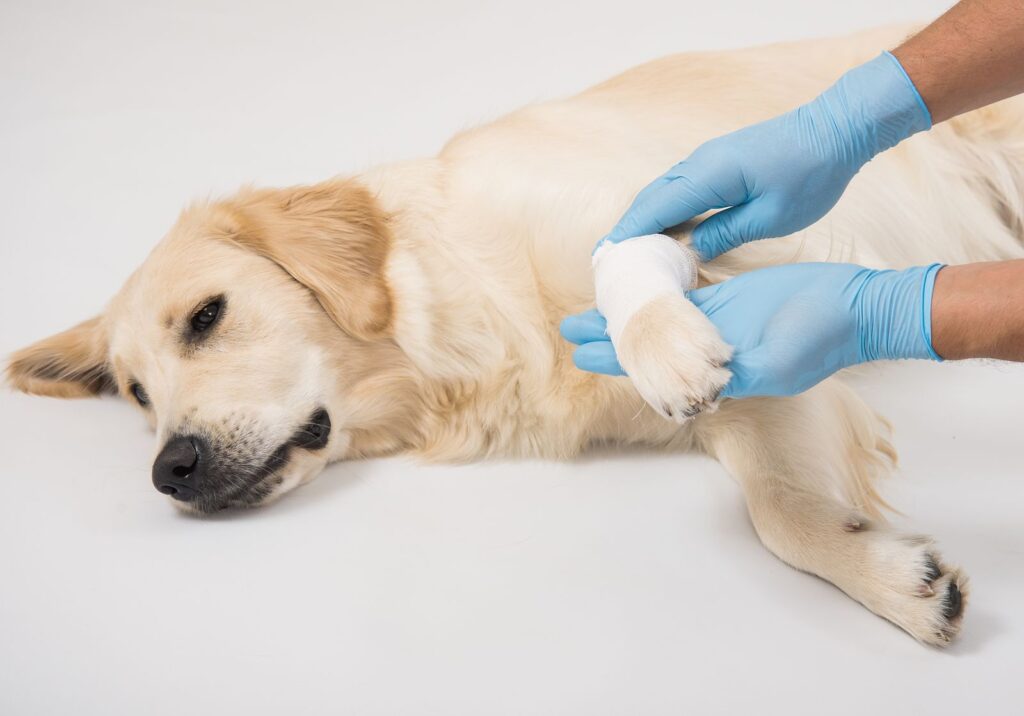Many people believe that giving the dog a Paracetamol pill saves them a visit to the vet. Those same people are the ones who think that the canine organism is similar to that of humans. Well, it's not, and giving dogs a drug that has been designed for humans is a serious mistake. So much so that you can drive your dog to death by giving him Paracetamol.

Why Never Give Paracetamol to Your Dogs?
Some pet owners adopt the bad habit of stocking their own medicine cabinet every time their dog exhibits symptoms similar to a human ailment, such as a cold or vomiting. In this way, they medicate their dogs with medicines that humans use frequently, such as ibuprofen, paracetamol or aspirin, without being aware that they are putting their dogs at risk.
First of all, we should never give our dog medication without the recommendation of a veterinarian, as it can be fatal. Administering paracetamol to your dog is perhaps one of the worst decisions you can make when it comes to your pet's health. Every time your dog shows symptoms of any disease, you should request the opinion of the specialist, since his experience in preventing, diagnosing and treating any condition is of great value.
What is Paracetamol?
Paracetamol, also known as acetaminophen, is a frequent drug in the medicine cabinets of all homes and it has analgesic and antipyretic qualities, primarily used to calm fever and pain in humans. It can be purchased without the need for a prescription, usually without side effects. Perhaps this ease of acquisition and use makes us forget that it is a drug and, as such, it will present a series of side effects that, in dogs, will be more serious than in humans.
It is normal for paracetamol to be toxic in dogs if it is administered directly by the owners without first consulting with the veterinarian. In addition, as it is sensible to consider, it is not metabolized in the same way in all species, and in dogs it can damage the liver, giving rise to the clinical picture that we will see in the next section.
Symptoms of poisoning
Dogs can be given paracetamol, but in very small doses. The usual dose of paracetamol used in treatments for dogs is 15 milligrams per kilo and the fatal dose is 150 milligrams per kilo. Paracetamol is usually marketed for humans, in 1.000-milligram tablets, which means that if, for example, we give a seven-kilogram dog a tablet, we will have exceeded the lethal dose and, possibly, the dog will perish.
When paracetamol is ingested by an individual, the drug mixes with blood proteins, which hinders the transport of oxygen. Added to this, when passing through the liver, in high doses, it produces necrosis in this organ. Due to the above, the most frequent symptoms when administering paracetamol to your dog are:
- Cyanosis: Some parts of the dog's body take on a bluish coloration. This occurs because the red blood cells no longer carry oxygen
- Tachycardia
- Dyspnea or respiratory disorders
- Jaundice: yellowish hue of the skin and mucous membranes due to liver failure
- Weakening
- foot swelling
- Stomach ache
- Threw up
- Inapetence
- Coma
Consequences of Paracetamol
The worst and most extreme effect of giving your pet paracetamol is his probable death. As we pointed out, it is a drug that prevents tissue oxygenation and causes severe damage to the liver. Paracetamol and the rest of non-steroidal anti-inflammatory drugs (NSAIDs) cause direct damage to the mucosa of the stomach, since, when combined with gastric juices, they increase its acidity much more.
On the other hand, they regulate prostaglandins, molecules whose task is to protect said mucosa. In low amounts, these consequences cannot be appreciated, but they are noticeable in intoxication due to overdose. Since paracetamol is metabolized by the kidneys, low doses can be easily excreted. However, in high doses it is reabsorbed and returns to the bloodstream.
This leads to reintoxication and more difficult excretion of the drug. Finally, the mixture of paracetamol with hemoglobin produces a molecule called methemoglobin, which does not have the ability to bind oxygen. Additionally, it causes hemolysis or extermination of red blood cells.
Paracetamol Poisoning Treatment
What we must first do in the event of a probable intoxication in your dog due to paracetamol is to go to the veterinarian as soon as possible. If possible, we have to tell him when and how much he has been able to eat. Regularly, poisoning by this drug is treated by digestive decontamination. First, it seeks to incite vomiting in the animal, if no more than four hours have elapsed since the paracetamol was ingested.
If it is not possible to induce vomiting, a stomach lavage is performed and activated charcoal is supplied, which has the capacity to absorb the molecules that remain free of paracetamol. If more time has passed and the damage suffered is greater, you can choose one of these antidotes:
- N-acetysteine: decreases the progression of liver failure, since it increases the levels of nitric oxide, which acts as a vasodilator and improves liver circulation.
- S-Adenosine-L-methionine: combines and disposes of the toxic metabolites of paracetamol.
- Ascorbic acid or vitamin C: converts methemoglobin to hemoglobin.
Alternatively, the dog can be kept on oxygen, to which can be added blood transfusions and treatment of acute kidney failure that may arise.
You may also be interested in these topics:


